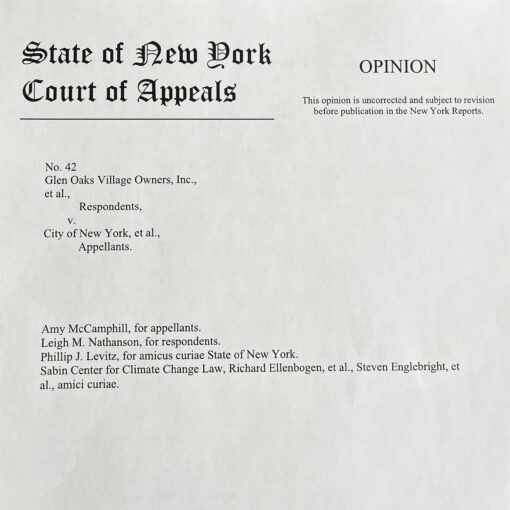 Last month, the Fordham Urban Law Journal published a paper I wrote titled The Legal Case for Equity in Local Climate Action Planning. In the last several years, cities’ climate action plans, or CAPs, have increasingly incorporated equity and justice objectives and metrics alongside more traditional greenhouse gas reduction measures across the buildings, transportation, waste, and energy sectors. By incorporating equity and justice into their plans, cities are acknowledging the disproportionate harm that climate change can cause in low-income communities and communities of color, and at times also the inequitable impact that policies to address climate change can have for disadvantaged communities and households. Often, these disparities and inequities are more acute for members of underrepresented racial and ethnic groups, leading some local governments to develop policy interventions that speak directly to that disproportionate treatment. A 2022 study from Boston University reports that, as of June 2021, 58 of the 100 most populous cities in the U.S. had CAPs, and 69 percent (40 cities) of those were “attentive to justice” in some way. Anecdotally, the number of such plans has increased since.
Last month, the Fordham Urban Law Journal published a paper I wrote titled The Legal Case for Equity in Local Climate Action Planning. In the last several years, cities’ climate action plans, or CAPs, have increasingly incorporated equity and justice objectives and metrics alongside more traditional greenhouse gas reduction measures across the buildings, transportation, waste, and energy sectors. By incorporating equity and justice into their plans, cities are acknowledging the disproportionate harm that climate change can cause in low-income communities and communities of color, and at times also the inequitable impact that policies to address climate change can have for disadvantaged communities and households. Often, these disparities and inequities are more acute for members of underrepresented racial and ethnic groups, leading some local governments to develop policy interventions that speak directly to that disproportionate treatment. A 2022 study from Boston University reports that, as of June 2021, 58 of the 100 most populous cities in the U.S. had CAPs, and 69 percent (40 cities) of those were “attentive to justice” in some way. Anecdotally, the number of such plans has increased since.
Until now, the discourse on equity in local climate action planning has largely been limited to policy questions. My paper adds to the legal literature a discussion of why local governments are at times effectively compelled, or at least strongly encouraged, by federal law to imbue their climate action planning with considerations of equity and climate justice. While none of the federal law drivers I identified are a “silver bullet” that will definitively compel more equitable climate action planning at the local level, I view expanding the literature on the legal context as critical to preventing equity-infused local climate action planning from falling by the wayside when it becomes costly and challenging. In other words, we need to articulate why equity-infused CAPs are legally sound and legally compelled.
The article identifies three areas of federal law that can provide legal bases for local climate action planning that is procedurally and distributionally equitable. None of them are perfect. But as my article argues, by ignoring equity in local climate action planning, a city is at best leaving federal dollars on the table and at worst acting as a “passive participant” in contributing to inequality via climate policies under which low-income and BIPOC communities fare worse than wealthier, largely white residents.
(1) Fourteenth Amendment Equal Protection Clause
The Equal Protection Clause of the Fourteenth Amendment of the U.S. Constitution prohibits discrimination on the basis of race, among other protected characteristics. While the Equal Protection Clause has generally not been a fruitful avenue for ex post litigation by plaintiffs with environmental justice complaints against governmental entities, it offers local governments a prospective logic for considering the discriminatory impacts of their climate policy. More specifically, one strain of Equal Protection case law relating to race-conscious procurement and hiring policies at the federal, state and local government level sets out the parameters at play when a court considers whether such a race-conscious policy should survive strict scrutiny: namely, that to survive strict scrutiny review, a race-conscious procurement policy must advance a “compelling governmental interest” and be “narrowly tailored” to address that interest. A “compelling governmental interest” may be established by appropriately demonstrating with specificity the scope and nature of racial discrimination that the government seeks to address. Factors that can demonstrate that narrow tailoring include: (1) trying first to use race-neutral policy means; (2) limiting race-conscious program elements in time; (3) setting race-conscious goals in relation to the appropriate statistical pool; and (4) allowing for a waiver where race-conscious policy aspects cannot be met despite good faith efforts.
In the procurement context, cities – with the help of consultants – have long conducted the “disparity studies” that can establish discrimination in the relevant market sufficient to establish a compelling governmental interest and to craft narrowly tailored policies in response. My paper argues that this logic can be extended to the climate context. For example, one could imagine that, with the appropriate study and documentation of discriminatory housing policy, efforts to retrofit buildings in communities of color could be justified as remedying discrimination in local housing markets (in some places, it could have the opposite effect). The plurality of the Supreme Court goes even further than this in City of Richmond v. J.A. Croson (1989), writing “if [a] city could show that it has essentially become a ‘passive participant’ in a system of racial exclusion practiced by elements of the local construction industry, we think it clear that the city could take affirmative steps to dismantle such a system.” (The Croson Court invalidated the Richmond, Virginia policy at issue, but said that a similar policy could be upheld if it satisfied the strict scrutiny standard of demonstrating a “compelling governmental interest” and a “narrowly tailored” policy response.) In many communities around the country, climate impacts and at times the policies meant to address climate change are a “system of racial exclusion,” and while there is a lot of place- and fact-specific work to be done in a locality to demonstrate that, the Croson plurality suggests a moral imperative for local governments to consider their roles in broader discriminatory systems.
The Equal Protection arguments in support of race-conscious climate action planning are admittedly normative ones. The Equal Protection Clause makes the consideration of race in governmental policymaking a legally and administratively cumbersome undertaking subject to strict scrutiny review. And recent Supreme Court cases have made it clear that race-conscious policymaking will be increasingly vulnerable to legal attack. But courts have made a strong moral argument for local governments to consider equity – racial and socioeconomic – in a once-you-see-it-you-can’t-unsee-it sort of way. As the Croson plurality writes, “[i]t is beyond dispute that any public entity, state or federal, has a compelling interest in assuring that public dollars, drawn from the tax contributions of all citizens, do not serve to finance the evil of private prejudice.”
(2) Title VI of the Civil Rights Act of 1964 and Agencies’ Implementing Regulations
Title VI of the Civil Rights Act of 1964 prohibits discrimination “on the ground of race, color, or national origin” by activities receiving federal funding. By way of implementation, Section 602 of Title VI requires federal agencies to “issu[e] rules, regulations, or orders of general applicability” to ensure those agencies’ compliance with Title VI. Local and state governments are subject to these agency implementing regulations when they seek federal funding or approval for their actions; a federal agency or department may enforce their Section 602 regulations by “termination of or refusal to grant or to continue assistance” to a recipient, including a local government, that fails to comply with them.
While a wide range of federal agencies and departments have Section 602 implementing regulations, my paper focuses on the Federal Highway Administration’s (FHWA) regulations as they apply to the highway construction and expansion projects that bisect cities nationwide. The FHWA’s regulations require states and state transportation agencies (including units of local government) to make assurances that “no person… on the grounds of race, color, or national origin be subjected to discrimination under any program or activity” receiving assistance from the FHWA or the U.S. Department of Transportation. Importantly, “discrimination” is defined as “intentional or unintentional” action. States and state transportation agencies are further required to make “good faith effort[s] to eliminate past and present discrimination in all federally assisted programs , and to ensure future nondiscriminatory practices.” Functionally, then, the FHWA’s Section 602 regulations require local governments to imbue aspects of transportation policy – a major driver of greenhouse gas pollution – with equity.
The role of the FHWA’s Section 602 regulations is more than academic. In recent years, several highway expansion projects were paused or delayed due to Title VI complaints. First, the expansion of Houston’s I-45 – which tore through largely Black and Latinx neighborhoods in the mid-20th century as part of systemically and sometimes overtly racist efforts to use highways to segregate and destroy communities of color – was paused by the FHWA due to “serious Title VI… concerns” raised by stakeholders in formal complaints. Soon after, the Wisconsin Department of Transportation announced that it would undertake a supplemental environmental impact statement in connection with the expansion of I-94 in Milwaukee, with a spokesperson noting that the review “will help us make certain that our efforts to ensure racial equity with this project are comprehensive and aligned with federal priorities.” In Portland, Oregon, the expansion of I-5 was redesigned to include a cap over the expanded highway that would reconnect a neighborhood torn apart by I-5’s initial construction, in part due to Title VI considerations.
As with the Equal Protection arguments above, Title VI is an imperfect tool for infusing equity into local CAPs. For one, it is worth noting that Section 602 of Title VI does not give any party an affirmative right to sue over noncompliance with the FHWA’s regulations (though lawsuits were filed against state transportation agencies in Houston and Portland under other federal laws). More concretely, the Houston, Milwaukee, and Portland projects were all eventually permitted to proceed.
But Title VI does offer an administrative complaint process that allows for further examination of racially disparate impacts, and it puts state and local agencies on the hook for compliance with a wide array of agencies’ Section 602 regulations, lest they risk losing needed federal funding or approvals. A local government would have to essentially opt out of federal support to avoid compliance obligations under Section 602 regulations, an increasingly untenable proposition given the growing federal funding opportunities available.
(3) Recent Developments: the IRA, IIJA and Justice 40
While Equal Protection and civil rights law do support integrating equity into CAPs, the arguments behind them are normative and highly legalistic. A more direct approach to equity-infused climate action planning can be found in recent developments in federal law, which effectively require governments to consider equity in their GHG mitigation policy through federal funding parameters.
One important development is the Biden Administration’s Justice40 commitment, which pledges that “40 percent of the overall benefits [of certain federal climate and energy spending] flow to disadvantaged communities.” Several hundred federal programs are now subject to Justice40, including a wide range of programs relied on in climate-adjacent urban and local policy such as transportation, housing, and environmental protection. Justice40 pertains to federal funding – it does not require local governments to direct their own funds in any particular manner. But it makes a compelling case for local governments to develop and present projects to federal agencies that prioritize disadvantaged communities. Working with these communities to identify opportunities for climate and clean energy investment will position local governments to make the case for federal funding.
In addition to Justice40, two major federal laws – the Inflation Reduction Act (IRA) and the Infrastructure Investment and Jobs Act (IIJA) – are and will continue to direct significant funds to low- and moderate-income residents and so-called disadvantaged communities, among other places. Pursuant to Executive Orders, Justice40 overlays both of these laws.
The IIJA allocates funding for public transit, electric vehicle charging, and electric school buses, all areas that have intersecting implications for climate and equity. Most of this funding will not flow directly to local governments, but some of it has and will continue to do so, while other funds will be allocated to states, NGOs, businesses and others to advance projects that have equitable and climate-positive impacts. A local CAP can help inform even these efforts by non-governmental actors.
The IRA allocates even more funding for climate and clean energy (the estimates start at nearly $400 billion and go up from there). Of the Congressional appropriations made in the IRA, $40 billion is estimated to flow into environmental justice communities or to low-income individuals. For many IRA programs, Congress has specified that a certain share of program funds must be spent in a disadvantaged community, while the remainder may be spent in any community (at times, the percentage breakdown mirrors the Justice40 commitment). Some appropriations also fund activities that are widely understood to address historic and ongoing inequities in climate policy, such as the appropriation for highway deconstruction and other transportation projects like greenways and providing access to transit hubs. Many of the IRA’s rebate programs and tax incentives also prioritize low-income communities and amplify incentives for low- and moderate-income households, while others that are more likely to be used by businesses than individuals also prioritize an equity-infused planning approach by offering bonus credit amounts for siting in low-income communities, meeting prevailing wage requirements, and more. In all of these regards, local governments are encouraged to consider both aligning their own CAPs with benefits to disadvantaged communities and how they might work with businesses and residents to encourage investment in areas or to serve residents that qualify the projects for enhanced credits.
Conclusion
As my paper asserts, the increasing number of local governments pursuing an equity-infused local climate action planning approach can find support from more federal law sources than have previously been identified. While local governments have significant flexibility in developing their CAPs, federal law shapes the requirements and opportunities for equity-infused climate action planning, especially though not exclusively where federal funding is involved. By identifying sources of support in federal law, my article aims to help shield local equity-infused CAPs from legal attack, and to offer arguments in favor of such an approach where one is alleged to be unlawful. Local governments and advocates for local equity-infused climate action planning can find support in federal law and should amplify these federal law opportunities to support an equitable and just climate policy approach.
For a more in-depth read, see The Legal Case for Equity in Local Climate Action Planning in the Fordham Urban Law Journal here.
Amy Turner is the Director of the Cities Climate Law Initiative at the Sabin Center for Climate Change Law at Columbia Law School.





